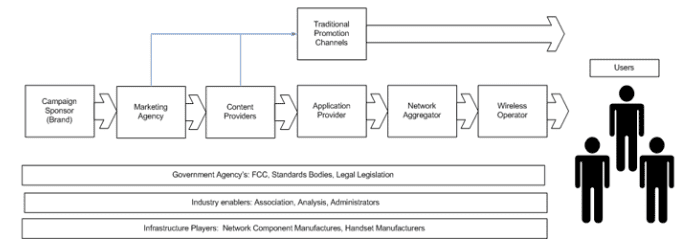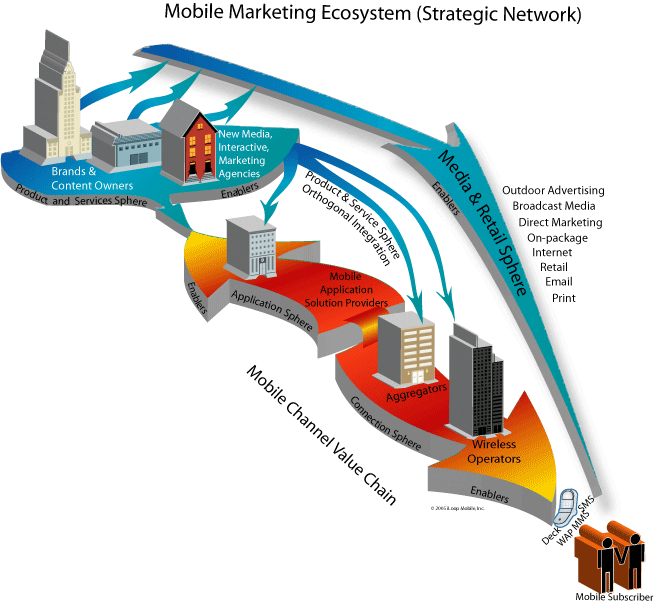Mobile phone use for services beyond voice is at the tipping point of exponential growth in the United States. Mobile subscribers in June of this year exchanged 7.25 billion text messages across US mobile networks, up from 2.5 billion in June of last year (CTIA 2005). IVR, multimedia, gaming, mobile micro-sites
The Mobile Marketing Ecosystem is driven by a number of technical, regulatory, commercial, social and legal components. It is a complex network of different industries and companies, and to be successful in leveraging the mobile channel it is important for brands, content owners, marketing agencies, and other industry participants to be aware of how value is generated through this channel and within the system. This paper discusses the Mobile Marketing Ecosystem, sheds light on a strategic framework for evaluating it, and encourages industry players and scholars to be aware of its constantly changing landscape.
Michael Porter’s 1985 seminal work on value chain and value system frameworks provides us with strategic concepts for evaluating businesses and industries. Managers use Porter’s framework to identify the unique technological and economic activities of a business or industry, and the critical linkages between each activity. Once these activities are identified, managers can focus on their core competencies and solidify their position within the industry (Porter, 2005). Porter’s work, however, takes a two dimensional approach at both the business and industry level. With his value chain framework, a company uses primary and support groups to create products or services in order to add value. A company can collaborate with another company that will add value, this second company can perform another handoff, and this process continues through the industry value system until the customer consumes the product. Many have used Porter’s framework (Becker et al. 2004; Kaplan 2005) to develop a map of the Mobile Marketing Ecosystem, as shown in Figure 1 below.
Figure 1: Traditional Approach to Viewing the Mobile Marketing Ecosystem
As early as 1993, however, scholars recognized that an industry’s value system is not limited to a simple linear two-dimensional view, rather it is made up of a constellation, or a strategic network, of companies that do not necessarily work in a serial fashion as in the traditional value chain models. A better way to understand the interrelationships between each network is through the lens of the dynamic multidimensional strategic network model (Moller et al. 2002; Normann & Ramirez 1993; Sutinen & Tirri 2005), where each network within the Mobile Marketing Ecosystem described below is labeled a sphere. It is not that Porter necessarily missed anything with his original work, but as the Internet and wireless networks emerged, standards solidified, globalization sped up, new processes, technology, economic models, and business practices formed, and the landscape of doing business altogether changed. This change does not mean that fundamental economics no longer apply. Everyone throughout the strategic network must receive at least marginal returns, otherwise they will not survive in the network, or the network will be unstable and lasting value will not be created. These changes are pervasive, dynamic, and encouraged by participants in the mobile ecosystem, including organizations like the Mobile Marketing Association, CTIA, Neustar, mobile operators, marketers, aggregators, application providers and other participants.
At their conception, mobile services with their unique capabilities and opportunities were exclusively “bundled” within the mobile operators’ technology network, a “walled garden” controlled by the mobile operators with limited access provided to others. Anderson and Williams have documented in detail the “unbundling” that is now occurring within the mobile operator’s value chain system (Anderson & Williams 2004), and it is this unbundling that has opened mobile marketing to brands and content owners, and created the fertile ground for existing and new industry players like mobile application providers, aggregators, and enablers. The discrete application providers and application solution providers (also known as “mobile ASPs”) are offering exciting and novel technology for a wide array of mobile initiatives and mobile management systems. The aggregators are providing single-point connectivity with all the different mobile operator networks. The enablers are providing foundation technology, processes, regulations and related support to the value activities within each sphere. With the controlled and managed opening of the mobile operator’s walled garden, traditional brands, content owners, and marketing agencies are now able to use mobile networks for direct customer engagement. Brands are not only distributing services and content through the channel, but are using it for brand awareness, prospecting, customer acquisition and customer retention purposes.
New mobile content, “experiential marketing” and interactive mobile services are also emerging. An excellent example is Counts Media and its Yellow Arrow program. The Yellow Arrow program invites anyone to create a mobile experience by placing Yellow Arrow stickers at locations or on objects around town that they think is of interest, cultural importance, or just fun, and they then “program” the arrow via SMS with a text story or information explaining its significance. The sticker has a unique keyword written on it that other people will see. People text message this keyword to a short code, which results in a reply text message containing the story. For example, someone could leave a Yellow Arrow at a warehouse door entrance, leaving a story that will explain either by text or voice the history of the location– “this is where Andy Warhol’s original Factory was located”. Leveraging multiple strategic partners throughout the ecosystem network, Counts Media created a new genre of service—the “mix reality entertainment experience”—by turning the world into a canvas and using the mobile phone as the brush. Counts Media’s VP of Business Development Karenne Rossi notes how the Yellow Arrow project creates “theatrical moments” to be shared with anyone that happens by and responds to the arrow’s call (Rossi 2005). Other emerging services are also prevalent. For example, the Coca-Cola Company has recently enabled the purchase of branded mobile content from its vending machines (Clark 2005). Disney is launching their own proprietary mobile network (MVNO), and is also developing new channels, including mobile, to deliver its content. Disney CEO Robert Iger believes that, “In the future, there will be a percentage of people who will only receive our content on devices other than television sets” (Wall Street Journal, 2005). Mobile application providers, content providers, aggregators and new interactive marketing agencies, among others, are joining forces within the Mobile Marketing Ecosystem’s strategic network to help these and other brands succeed.
None of this would have been possible just a few years ago if it were not for the changes that are taking place in the ecosystem. The figure below (Figure 2) illustrates the new and dynamic Mobile Marketing Ecosystem, a strategic network encompassing all industries, marketing disciplines, and economic and technical models. It is comprised of 4 interconnecting spheres–Product & Services (brands, content owners and marketing agencies), Applications (discrete application providers and mobile ASPs), Connection (aggregators and wireless operators), and Media and Retail (media properties, “brick ‘n’ mortar” and virtual retail stores). Various enablers provide the foundation for each particular sphere. Players within these spheres work in concert to deliver a rich experience to consumers. The Mobile Channel Value Chain is the path by which the actual mobile communication and interactivity takes place between the Product & Services Sphere and mobile subscribers (consumers), however, consumer demand must first be established. To create this demand, products, services, events, and content programs are promoted through the Media and Retail Sphere’s various traditional channels. By adding the mobile component, traditional media becomes “untethered” from its previous limitations and becomes a true interactive medium. Print media, for example, is a relatively static medium that is normally only passively viewed by the consumer, with limited access to respond promptly to a call to action. With a mobile component added, the consumer can execute a call to action anytime, anywhere it is viewed. Once a mobile relationship is established with the consumer through the Media & Retail Sphere, brands and content owners can then request permission to communicate directly with the consumer further through the mobile channel.
Figure 2: Mobile Marketing Ecosystem
It is imperative that companies from the different spheres learn to coordinate their efforts and develop strategic relationships with players in the other spheres of the Mobile Marketing Ecosystem. While it is tempting for a company to try to be everything to everyone and attempt to horizontally integrate multiple functions across multiple spheres, they should take heed before doing so since each sphere comes with is own unique business models, regulations, technologies, relationships, norms and practices. It is vital that companies focus on their core competencies and work collaboratively with other players within the strategic network to best service the market. If major players attempt to control areas that are outside of their core competencies, the most likely result would be an inefficient industry plagued by high cost, slow reaction to market needs, consumer dissatisfaction, and the stunting of new technologies and creative ideas. This issue is critically important to mobile industry participants and business scholars as well. Scholars can help analyze, define, and empirically test the links between value creation activities within the ecosystem in order to provide managers with appropriate system models and decision-making data. In the coming months and years, the ecosystem will continue to mature and stabilize. The participants in the different spheres can create lasting value for the industry and its consumers by working together.
References
Anderson, J., & Williams, B. (2004, Fall). Unbundling the Mobile Value Chain. Business Strategy Review, 15(3), 51-57, 7p.
Becker, M., Sharpe, J., & Silveria, K. (2004, April). The Emergence and Integration of the Mobile Channel with Marketing Practices in the United States., Golden Gate University DBA, San Francisco.
Clark, N. (2005, 14/Sept.). Coca-Cola vending machines to offer mobile content. Retrieved 9/15/05, from Incentive Bulletin:http://www.brandrepublic.com/bulletins/incentive/article/516692/cocacola-vending-machines-offer-mobile-content/.
CTIA. (2005, 27/Sept.). Mobile Marketing Association. In Marketing- The Mobile Channel. CTIA Wireless I.T. & Entertainment 2005 San Francisco: Mobile Marketing Association & CTIA.
Kaplan, M. (2005, 27/Sept.). Mobile U. In Marketing- The Mobile Channel. CTIA Wireless I.T. & Entertainment 2005 San Francisco: Mobile Marketing Association & CTIA.
Marr, M. (2005, 1/Oct). In Shakeup, Disney Rethinking How It Reaches Audiences. The Wall Street Journal (New York), Weekend 67 ed., p. 1.
Moller, K., Rajala, A., & Svahn, S. (2002, Sept.). Strategic business nets--their type and management. Journal of Business Research, 58.
Normann, R., & Ramirez, R. (1993, Jul-Aug). From Value Chain to Value Constellation. Harvard Business Review.
Rossi, Karenne. (2005, Oct). Interview.
Simmons, J. (Director, CTIA). (2005, 27/Sept.). Marketing - The Mobile Channel. In Marketing- The Mobile Channel. CTIA Wireless I.T. & Entertainment 2005 San Francisco: Mobile Marketing Association & CTIA.
Sutinen, J., & Tirri, J. (2005, May). Mobile Advertising Strategic Net: A Study of Actors and Activities., FACULTY OF ECONOMICS AND BUSINESS ADMINISTRATION, University Oulu, Finland.



No Comments.